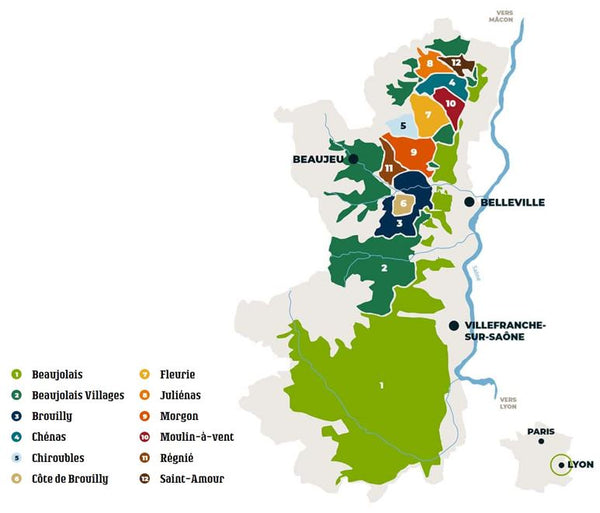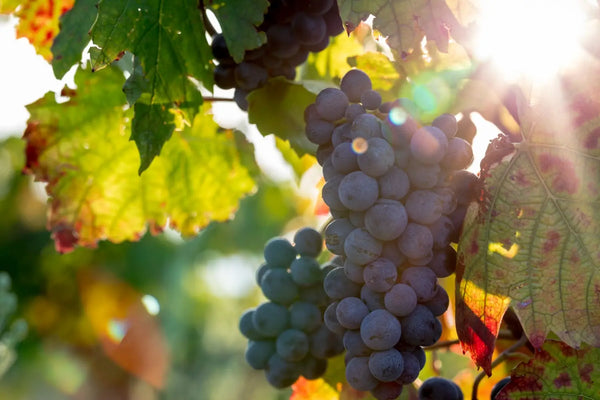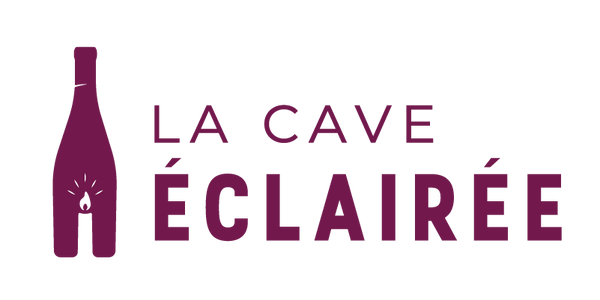The
Beaujolais is often reduced to a production of
simple, fruity, and light wines based on the Gamay grape variety. Moreover, Beaujolais Nouveau is often mentioned in discussions and tarnishes the reputation of the vineyard for many people . Nevertheless, the region is indeed
capable of producing rich, complex, and well-aging wines thanks to superb terroirs and passionate winemakers!
In this article, we will explore the geography of the Beaujolais vineyard as well as its different appellations, while highlighting the 10 regional crus .
After reading this, you will have changed your mind about Beaujolais! Follow the guide...
Climates, terroirs, and grape varieties of Beaujolais
Nestled between Burgundy (south of Mâcon) and the Rhône Valley (north of Lyon), Beaujolais benefits from a temperate semi-continental climate with oceanic and Mediterranean influences.
Furthermore, while 97% of the production is reserved for red wines based on the Gamay grape variety, the varied terroirs of granites, schists, clays, and limestones give the produced cuvées a great diversity of profiles.
The remaining 3% is dedicated to the small production of white wines based on the Chardonnay grape variety.
What are the appellations of Beaujolais ?
At the base of the hierarchy of Beaujolais appellations, there are first 4 regional AOCs.
The AOC Beaujolais
It is the most important in the region and although covering the entire vineyard, it is mainly located in the south of the latter. Furthermore, while the production is almost exclusively based on the Gamay grape variety, 300 hectares are also dedicated to the production of white wine from Chardonnay. Whether white or red, the wines of this appellation generally express a light, fresh, and fruity character.
The AOC Beaujolais Villages
It is located in the northern part of the region and covers 38 communes. The vines in
AOC Beaujolais Villages are situated on average at more than 300m altitude and thrive on the best slopes of the region. Here too, the wines are known for their
fruity and indulgent character and can be enjoyed in their youth or after a few years in the cellar.
The AOC Beaujolais Nouveau
It is perhaps the most well-known of the vineyard and is in any case the most important in terms of production. Indeed, the Beaujolais Nouveau represents nearly a third of the entire vineyard's production ! From a geographical point of view, it overlaps with the Beaujolais and Beaujolais Villages appellations.
Every year, on the third Thursday of November, Beaujolais Nouveau is the first wine of the current vintage to be sold. As you can imagine, it is a light, fresh, and very fruity wine intended to be consumed as an aperitif.
The AOC Coteaux Bourguignons
As its name suggests, the AOC Coteaux Bourguignons is primarily located in Burgundy, but it also exists in Beaujolais and allows for the production of red and rosé wines based on the Pinot Noir and Gamay grape varieties. These can be either vinified alone or blended. The production of white wine is also possible from the Aligoté, Chardonnay, Pinot Blanc, Pinot Gris, and Melon de Bourgogne varieties.
The wines are clearly designed to be enjoyed as an aperitif and offer a very pleasant fruity character but little complexity.
In addition to these 4 regional appellations, Beaujolais also has 10 crus (or appellations), which contribute to the vineyard's reputation. Let's now explore them !
What are the 10 crus of Beaujolais ?
Located in the northern part of Beaujolais, 10 crus coexist within the region, each possessing unique characteristics. From north to south, here is their comprehensive list.
Juliénas
The Juliénas appellation extends over 4 villages and 575 hectares. Its vines thrive on very varied soils : indeed, there are blue stones (volcanic rocks so called because of their bluish reflections), granitic terroirs, foothills (alluvial soils composed of gravel, sand and clay) or even schists. The altitude here varies between 230 and 430m.
The Juliénas wines are medium-bodied wines often expressing notes of red fruits (strawberry, raspberry), a floral touch (violet, peony) as well as a slight spicy framework (cinnamon).
Saint-Amour
A vintage with a name that cannot leave one indifferent ! If
Saint-Amour indeed has the advantage of instinctively evoking
romance and passion, the quality of its wines is also very interesting.
Spanning 315 hectares within the only village of Saint-Amour-Bellevue, the soils here are composed of foothills, granites, blue stones as well as clays and limestones.
The wines produced can be
light and delicious (red fruits, floral notes) but can also express more
power and aromatic depth (black fruits, slight tannic structure, spices).The
cuvée Villa Violettes from
domaine Cheveau is exactly between these two types of wine!
Chénas
With its 250 hectares spread over 2 villages, Chénas is the smallest of the crus of Beaujolais. Its name comes from the ancient oak plantations that were present here during the Gallo-Roman era.
The appellation offers generous, silky wines with soft tannins, evoking black fruits, spices, and some floral notes.
Moulin-à-Vent
The appellation takes its name from the windmill nestled among its vines and dating from the 15th century. Comprising 640 hectares, this cru is spread over two villages.It is also the only one not to bear the name of a commune ! This one is considered the "King of Beaujolais" due to the power and structure of its wines. The soils rich in manganese indeed contribute to the robustness and density of the produced cuvées.
Aromas of black fruits, spices, violet, a mineral touch, as well as a
good aging potential are the main characteristics of Moulin-à-Vent wines.
Fleurie
With
840 hectares evolving almost exclusively on
pink granite soils,
Fleurie is an appellation with a particular geography.This one is indeed
backed by a chain of ridges and offers, with the hill of the Madone, a magnificent panorama over the entire vineyard. It is very likely thanks to these beautiful landscapes that the town of Fleurie was named as such.
The Cru is renowned for producing
delicate and elegant wines, considered as
the most feminine of Beaujolais. The
Cuvée Tardive from the Clos de la Roilette expresses, for example, all this sensuality and delicacy!
Chiroubles
With its 315 hectares, Chiroubles is one of the smallest crus in the region. The vines are planted here on pink granite terroirs and exclusively within the eponymous village.Moreover, the vineyard is located between 270m and 600m altitude, allowing the wines produced to retain freshness. Many plots also have steep slopes (regularly exceeding 30% !), consequently requiring manual harvesting and very meticulous work.
Thanks to all these factors, the appellation offers fresh, flavorful, and delicate wines with a silky and indulgent texture on the palate.
Morgon
Morgon is one of the most renowned appellations of Beaujolais and the largest of its crus. Its
1090 hectares are located exclusively in the commune of Villié-Morgon, on
terroirs composed of granite, blue stones, and alluvium. The vines are situated around 310m altitude.
The cuvées from the 250 winemakers of the appellation generally express
remarkable aromatic intensity and complexity. Morgon wines feature aromas of dark fruits (cherry, blackberry), violet, and a marked tannic structure, giving them
good aging potential. The different cuvées in AOC Morgon from
Vignobles Bodillard very well illustrate the richness and power of the region's wines.
Régnié
Régnié is the most recent of the Beaujolais appellations. Created in 1988, it now extends over 550 hectares located in two villages around 350m altitude. The soils here are predominantly granite and alluvial.
The wines of Régnié are characterized by
their suppleness and fruitiness. They are
elegant and fine, expressing aromas of red and black fruits (raspberry, strawberry, cherry, blackberry) as well as spicy and
mineralnotes.
Brouilly
Brouilly is one of the largest appellations in Beaujolais. With its
1200 hectares located around 290m altitude and its
very varied terroirs (pink granite, foothills, clay-limestone, blue stones, etc.), it is recognized for its production of
light, fruity and supplewines, pairing divinely well with appetizers and white meats.The
Brouilly cuvée from the Coudert estate (belonging to
Clos de la Roilette) perfectly illustrates the characteristics of this appellation.
It is also worth noting that while the AOC Brouilly starts further north than its neighbor Côte de Brouilly, it is the southernmost appellation of Beaujolais .
Côte de Brouilly
Located on the slopes of Mont Brouilly, this 310-hectare appellation surrounds its neighbor Brouilly . The soils here are composed of blue stones, granites, foothills, and scree.
Unlike Brouilly, the wines here are robust and intense , often requiring a few years of aging to reach their peak.In the aromatic markers present, we often find slightly liqueur-like dark fruits(notably cherry), spicy notes (pepper), as well as a certain minerality giving very fine balances to the whole
Conclusion
As you may have understood through reading this article,
the Beaujolais vineyard is not limited to its Beaujolais Nouveau and is a fascinating wine region. Indeed, it offers
a great diversity of wines ranging from fruity and light cuvées to
powerful crus , rich and intense, capable of long years of aging.
With its regional appellations and its 10 crus that you now know like the back of your hand, the region offers tasters
a rich and varied tasting experience that can be paired with many dishes. So, dive into the world of Beaujolais and let yourself be charmed by its authentic and delightful wines. Cheers from
La Cave Éclairée!
The Gamay grape variety
















